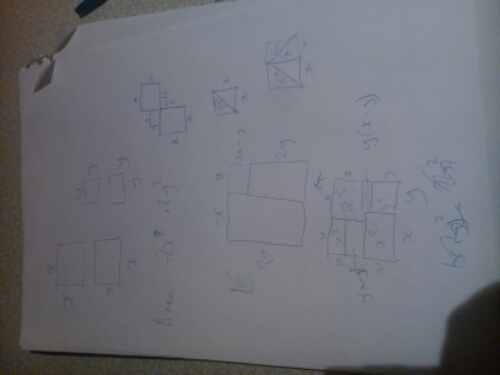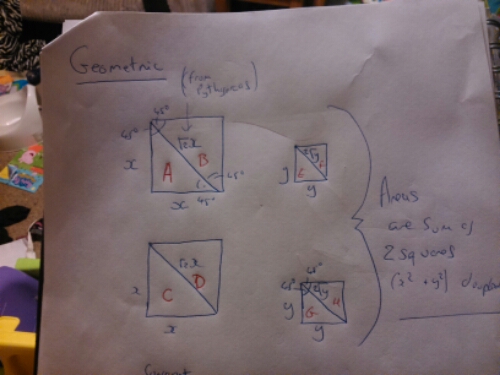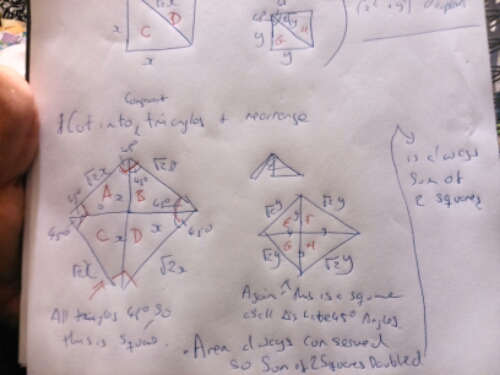Constructing a proof
Yesterday, while discussing this problem, my friend Steve posed this problem that he’d been thinking about:
The sum of two squares doubled is the sum of two squares. Prove it algebraically and geometrically.
Being the sort of person that can’t let a puzzle go unsolved I picked up a pen and set to work. I started with 2(x^2+y^2) and thought about where to go next. As I was doing this my brother (@andycav_25) posted
“1 seems to be always involved as one of the squares in the doubled bit”
then
“With 5 and 6 you get 122. 11^2 +1
2 and 3 give 26. 5^2+1
So it’s the sum of the first 2 squared plus 1″
I could see his error straight away, he had only tried consecutive numbers, I tried 2 and 6. 4+36 = 40 doubled is 80. 2+6=8 and 8^2 is 64. 80-64=16. And there you have it. It’s not the sum of the numbers squared add one, it’s the sum of the numbers squared add their difference squared. All I had to do now was construct a rigorous algebraic proof that would work for all numbers:
Nice isn’t it. The two squares are x^2 and y^2, their sum is (x+y) their difference is (x-y). Set up your equations, show they are equal and there you are, a proof that works for whatever numbers you like. The one case where it doesn’t fully work is where x=y. This relies on the second square being zero. However, the question relies on the same thing, as 2^2 + 2^2 doubled is 16, which is the sum of 4^2 + 0^2 but not any ‘other’ two squares. If 0^2 doesn’t count then this counter example disproves the statement. Perhaps the question should read:
Prove that the sum of two squares doubled is either a square, or the sum of two squares
That works better, and is how I’m going to pose it!
I like algebraic proofs, I’m comfortable with them, I’ve worked with them alot, I know how to do them and have been known to do them for fun. This is a good example of how they come about, you noticed a pattern, like Andy did, test some other numbers, like I did, hypothesise the general case and try to use algebra to prove it.
Geometric proofs, however, are a trickier beast. I didn’t opt for many geometry based courses at uni and I’m not as experienced at constructing the proofs. I’m never fully sure what constituents a geometric proof. Is a visualisation of an algebraic proof good enough, or is that just an algebraic proof expressed a different way?
I don’t shirk a challenge, however, so I wanted to have a go. It was even harder than I thought. Here are some early attempts:
Then I had thought I had had break through of sorts:
I thought I had cracked it, but now I’m not sure. I’ve lost a bit of confidence in it. Does it proof what it is supposed to? Area is definitely conserved. The total area of the top is definitely the sum of two squares doubled:
and the bottom is clearly two squares.
It works whatever size the squares are. However the implication in the question is that we are looking for integer side lengths, so I’m fairly sure it isn’t correct. Back to the drawing board!
Steve, who originally brought the puzzle to my attention, constructed this lovely visual proof:
We have 2x^2’s and 2y^2’s which make an (x+y)^2, and with an extra (the overlap) (x-y)^2 therefore 2(x^2 +y^2) = (x+y)^2 + (x-y)^2.
It’s definitely a proof, and a lovely neat one at that. Does it count as a geometric proof, or is it just a visual proof?
I’d love to hear your opinions. I’d also live clarification on what a geometric proof is. Do tell me if you can come up with a geometric proof that works.






The generalisation of that result is that if and are each expressible as the sum of two squares, then so is (your example being . The most elegant proof of which I am aware is this complex number proof, although it also has geometric and algebraic interpretations:
Observe that an integer being the sum of two squares is equivalent to it being the norm of a Gaussian integer, like so:
But norm is multiplicative, so we have:
You can verify algebraically that this is indeed equal to $mn$.